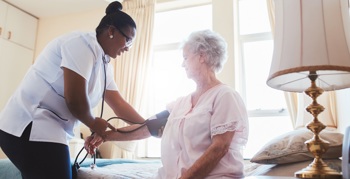
A functional virtual ward allows acute beds to be better utilised, enabling patients to recover in a more familiar and less stressful environment. This approach improves recovery outcomes and the overall healthcare experience.
In 2023, NHS England set a goal to deliver 24,000 virtual ward ‘beds’ (40-50 per 100k population) by the end of the year. As of late 2024, progress towards this target has been promising, with integrated care systems (ICS) continuing to expand their virtual ward offerings. NHS England has yet to announce specific goals for 2025, but further expansion is expected as virtual wards become integral to the health and social care sector.
Funding Support for Virtual Wards
Virtual wards require financial support, much of which comes from dedicated NHS funding. NHS England (NHSE) provided £250 million in match funding for FY 2023/24, and while no specific funding figures for FY 2024/25 have been confirmed, additional resources are expected under the NHS Urgent and Emergency Care Recovery Plan.
Integrated Care Boards (ICBs) will continue to receive Service Development Fund (SDF) allocations to support the delivery of national objectives, including virtual ward expansion. The SDF for 2024/25 will remain bundled into high-level groupings, as detailed in the Revenue Finance and Contracting Guidance for 2024/25.
While originally published under the Sunak Conservative government, as of January 2025, the Better Care Fund (BCF) also remains a key funding stream under the Labour government, aimed at “joining up health and care services, so that people can manage their own health and wellbeing and live independently in their communities for as long as possible.” This includes the Adult Social Care Discharge Fund, which is allocated to support local authorities up to the 31st of March 2025 and aimed at supporting “timely and safe discharge from hospital into the community by reducing the number of people delayed in hospital awaiting social care.”
The aims of these funds relate closely to the objectives of implementing virtual wards and may be utilised to support virtual ward projects.
Hospital at Home funding
With devolution, Scotland, Wales, and Northern Ireland have their own approaches to virtual ward implementation. In Scotland, the ‘Hospital at Home’ initiative has expanded significantly. In 2023/24, nearly 15,000 older patients used the service, representing a 24% increase from the previous year.
NHS Scotland allocated £3.6 million to 13 local healthcare providers to support Hospital at Home services, with NHS Borders receiving £600,000, among others. A report from Healthcare Improvement Scotland found that Hospital at Home saved an estimated £14.9 million in traditional hospital admission costs and a further £36.3 million in post-hospital care due to reduced readmissions.
Similar developments are underway in Wales and Northern Ireland, with funding allocations supporting digital innovations and infrastructure improvements.
Costs to consider when setting up a virtual ward
Setting up a virtual ward isn’t without cost or difficulties, but the rewards are worth the investments. Knowing how much you need to invest is part of the virtual ward challenge though, and it’s important to properly cost such a care development.
Below are two of the most commonly asked questions:
- How much does a virtual ward cost to set up? According to a Royal College of Nursing case study of South Eastern Trust virtual ward in Northern Ireland, the total set up cost for a virtual ward is approximately £32,974.
- How much does a virtual ward cost to run? The approximate annual operating cost for a virtual ward is £566,273, according to a Royal College of Nursing case study of South Eastern Trust virtual ward in Northern Ireland. This figure is subject to change due to the difficulty in measuring costs when assisted by other internal departments as part of existing duties or existing external partners who may report to other teams primarily.
These estimations are useful, but they are not wholly accurate. Virtual ward costs vary per region and relating to the NHS trust they are operating within, as well as based on what existing support is available in that area and the needs of the local population.
Recruitment and equipment are core costs. You need staff and you need kit. Both need to be managed and utilised properly. The NHS has its own recruitment pathways, but for software solutions it will need to outsource. The Access Group offers Access Assure, which is a digital telecare or home monitoring kit with related software to track a person’s vitals, but this is just one of many solutions available.
Other costs include things such as training courses, departmental meetings, leaflets and posters, whilst there are also indirect costs such as office space required for a team and desks.

Virtual ward costing model
A robust costing model is crucial for securing NHS funding and ensuring project viability. Trusts should clearly outline workforce costs, equipment provisioning, software expenses, and return on investment (ROI) in order to demonstrate value for money to the NHS.
Key areas to track in costing models include:
- Rostering (workforce + management costs
- Staff recruitment
- Staff training
- Provisioning (equipment + management costs)
- Software onboarding
- Advertisement/promotion costs
It is important to demonstrate that the best deals and supplier arrangements have been reached. No proof of market research and competition will not be looked upon favourably, whereas evidence of research and proof of product or service costs shows a pursuit of efficiency and proper management of the virtual ward project. The NHS is not looking to waste money, it is looking to invest in the future of the UK.
Are virtual wards cost effective?
The cost-effectiveness of virtual wards is increasingly evident. According to NHS England’s 2024 evaluation of the South East region, virtual wards generated savings exceeding £10 million by reducing hospital admissions and bed usage.
Medway NHS Foundation Trust is one of 32 NHS Trusts in the region running a remote monitoring program. Medway’s team cared for 356 patients on its 60-bed virtual ward and conducted 2,400 visits, mostly virtual. They concluded that the same level of care in a hospital would cost £657 per day, while costs of care on the virtual ward were only £187, saving over £100,000 in six months.
Similarly, Frimley Health Foundation Trust operates 10 virtual wards, including frailty, respiratory, and stroke wards, ranking among the highest-performing in the country for hospital avoidance. Since launching in December 2021, these wards have admitted 10,321 patients. Between October 2023 and January 2024 alone, over 2,300 hospital admissions were avoided. The frailty virtual ward has been particularly cost-effective, achieving a 96% admission avoidance rate and saving £631,000 annually.
A final costing perk is staffing. Statistics from Norfolk and Norwich University Hospitals NHS Foundation Trust reported zero sick days amongst their virtual ward team. The flexibility of virtual ward monitoring and support meant that staff who would not normally be permitted to work (due to the risk of spreading coughs, colds, and worse in the workplace) could perform lighter duties from the comfort and safety of home, including patient monitoring and patient check-in calls via tablet devices or laptops.
NELFT’s Virtual Ward Success
North East London NHS Foundation Trust (NELFT) has also demonstrated that virtual wards do indeed provide both financial and operational benefits. Since piloting Access’s virtual wards solutions in March 2024, the Acute Respiratory Infection (ARI) virtual ward has achieved significant measurable outcomes:
- ~30% reduction in readmissions
- 45% of admissions avoided
- 55% of virtual ward admissions focused on early supported discharge
These efficiencies have resulted in approximately 400-500 bed days saved between March and October 2024, allowing the Trust to better optimise resources while relieving pressure on acute hospital services.
NHSE Virtual Wards Operational Framework
In August 2024, following the NHS's announcement of an expansion to the country’s virtual wards initiative, NHS England (NHSE) updated its operational framework with new guidelines for providers.
The new framework is designed to support the NHS 2024/25 Urgent and Emergency Care Recovery Plan and sets out the following mandatory requirements for all virtual ward pathways:
- Ensure strong governance with leadership provided by a GP, consultant physician, or consultant practitioner.
- Operate daily from 8am to 8pm, with after-hours support available.
- Establish clear admission criteria and assessment protocols.
- Develop personalised care plans in collaboration with the patient, involving them in decision-making.
- Conduct daily ‘board’ rounds led by a senior clinician, with contributions from the multidisciplinary team.
- Provide access to hospital-grade diagnostic services.
- Offer hospital-level treatments and interventions.
- Utilise remote patient monitoring (RPM) and other technologies to deliver high-quality care.
- Optimise pharmacy services through medication reconciliation.
- Implement clear discharge procedures, including monitoring the patient’s length of stay.
Supporting Guidance Notes
NHSE has also published detailed guidance for implementing virtual wards specific to people with the following conditions:
These resources provide condition-specific best practices, from admission criteria to care pathways, ensuring a diverse range of needs are accounted for.
Virtual wards are evolving rapidly, and providers must stay updated on operational guidelines and funding opportunities. Download our comprehensive Virtual Wards Guide to learn more about setting up a virtual ward and leveraging innovative solutions to deliver high-quality, joined-up care.

